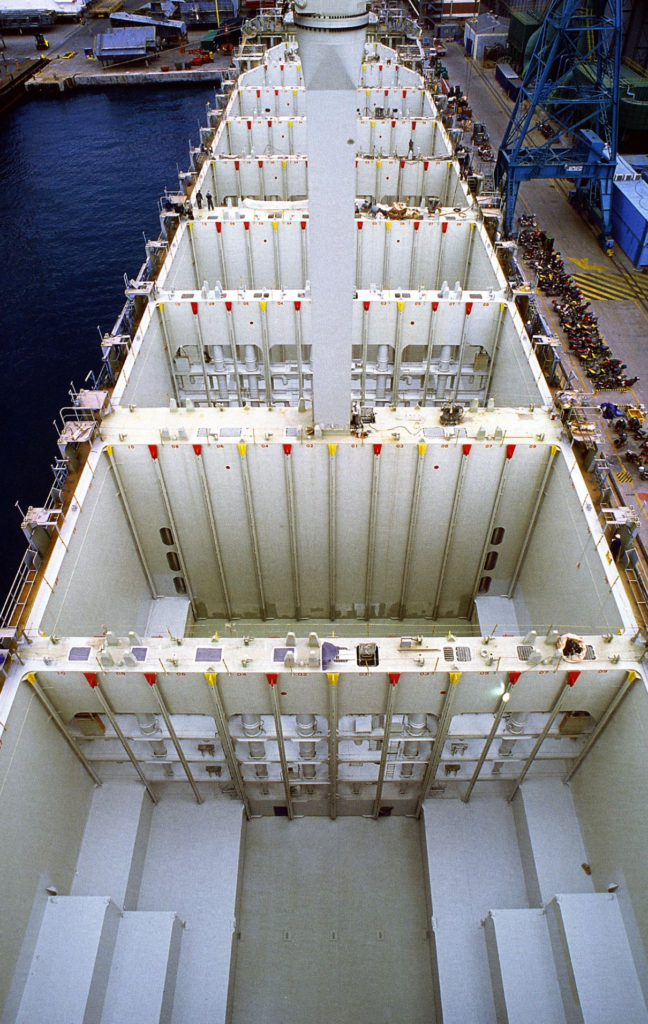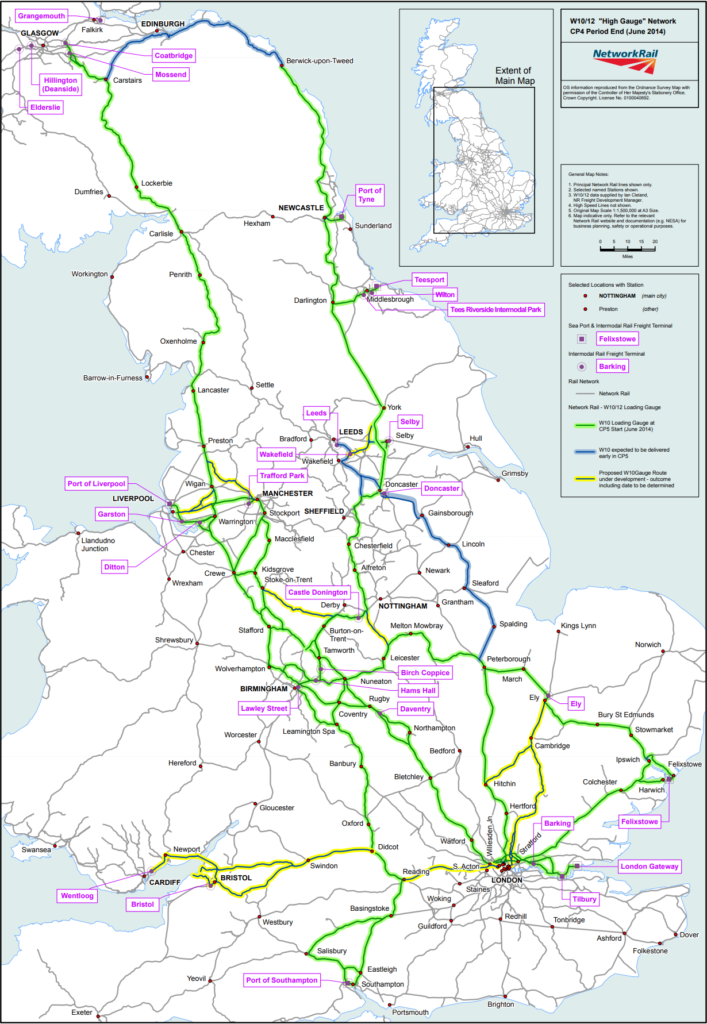…and the business of transporting manufactured goods across the world.
Seeing this video of the container ship Maersk Essex, I couldn’t resist trying to count how many containers she seemed to be carrying.
At the rear we see the stack is 19 containers wide and probably 10 containers high (guessing on how deep they go into the body of the ship) and it seems that the ship is about 20 containers long. That’s 19 x 10 x 20 = 3800 containers altogether. These containers are 40 ft long, twice the standard unit for calculating container loads, which is the TEU (Twenty-foot Equivalent Unit), so our calculation would seem to show that the capacity of the ship is 7600 TEU.
In fact our calculation is a significant underestimate. As this photo shows, containers are stacked well inside the hull of container ships.

The website marinetraffic.com gives more details of the MAERSK ESSEX. She was was built in 2011 and is sailing under the flag of Denmark. Her carrying capacity is 13,100 TEU and her current draught is reported to be 12.5 meters. Her length overall (LOA) is 366.44 meters and her width is 48.26 meters. At the time that I am writing, 24 November 2020, marinetraffic.com says she is on her way from Los Angeles and due to arrive at Yokohama on 2 December.
Consider the Maersk Essex to be fully loaded. That’s 366 x 48 x 12.5 m³ = 220,000 cubic metres and since each cubic metre of water has a mass of 1 metric tonne (1t), the total mass of water displaced is 220,000 t.
In fact the ship is not uniform and rectangular so in this case we have overestimated the displacement. In fact her Gross Tonnage is 141,000t.
Panamax and New Panamax ships
The Maersk Essex is an interesting size. She is just within the size for the new, wider, deeper Panama canal, which opened in 2016. The new canal sections increased the size of ships from 5000 TEU to 13,000 TEU, these sizes of ship being referred to as Panamax and New Panamax respectively.
There are significantly larger container ships. The HMM Algeciras built in 2020 is 400 m long and 61 m wide. It has a gross tonnage of 228,283t and a container capacity of 23,964 TEU. Ships like this which are larger than will fit through the Panama Canal are called post-Panamax or super-Panamax.
Suez canal
The Suez Canal now allows ships up to 400 m long with a beam of 50 m and a draft of 20.1 m. This is larger than New Panamax, leading to a maximum ship size of 160,000 tonnes, and a container load of around 14,500 TEU. In fact the Suez Canal has no locks and so there is no engineering limit on ship length, despite the regulation limit of 400 m.
Other pinch points around the world
Malaccamax, about 300,000 tonnes is a term used for the largest ships that can get through the shallow 25 m deep Strait of Malacca between Sumatra (of Indonesia) and Malaysia. Seawaymax, only 28,500 tonnes, describes the largest ships that can travel through the canal locks of the St Lawrence Seaway.
Standard container sizes
What we often refer to as a Shipping Container is technically an ISO Intermodal Container, designed for transporting goods in ships, lorries and trains without the goods being individually loaded or unloaded. The ‘standard’ ISO size is 20 feet (6.1 m) long x 8 feet (2.43 m) wide x 8 feet 6 inches (2.59 m) high. This is technically 1 TEU. Most containers are twice as long as that and a 40 ft container is obviously 2 TEU.
Hi-cube
Hi-cube containers are taller than standard containers at 9 ft 6 in (2.89 m). Hi-cube containers look distinctly taller than they are wide. By the end of 2013, half the word’s maritime fleet was in 40 ft hi-cube containers.
Other container sizes
In 2003 the EU commenced a process of defining the European Intermodal Loading Unit (EILU). The size of this container has yet to be defined, some 17 years after its proposal. It will be longer than 45 feet and, at 2.5 m about 10 cm wider than ISO containers. It will be difficult to fit it in with existing container ships. As can be imagined, the maritime freight organisations think it’s not a good idea.
From ship to rail and the problems of loading gauge
The size of freight allowable on trains is determined by what is called the loading gauge. European railways have loading gauges which are large and the transport of hi-cube ISO containers on such trains is no problem. Most of the British railway system is constructed to a loading gage called W6a. This is too small for the carriage of ISO containers.
W10 loading gauge allows standard wagons to carry ISO hi-cube containers. W12 allows room for these containers to have refrigeration packs as well. All new rail structures are built to W12 loading gauge.
There is a steady programme to enlarge UK railways to W10 and W12 loading gauge on the main rail freight routes so that containers can be offloaded from ships and then loaded directly onto rail lines for transport around the country but, as this map shows, only a small proportion of UK railways can carry the containers in which most goods are shipped.

How much does it cost to ship a container?
The website freightos.com gave me a price of $5,500 (£4,100) for the cost of transporting a 40 ft hi-cube container from Hong Kong to Felixstowe UK on 5 January 2021. The shipping time quoted was 31-37 days.
Ports.com tells me that this journey, via the Suez Canal, is 11,047 nautical miles and at a speed of 13 knots will take 35.4 days.
http://ports.com/sea-route/port-of-hong-kong,hong-kong/port-of-felixstowe,united-kingdom/
How much fuel is used to bring our container to the UK?
As the following link shows, 13 knots is a particularly slow speed. A normal speed is over 20 knots. I’m going to use this figure to read off a fuel consumption for a contain ship carrying our container.
The graph says that a ship of 10,000 TEU will consume about 180 t per day. To calculate the worst case scenario, I am going to assume that the ship still takes 35 days to travel from Hong Kong to Felixstowe.
So total fuel used is 180 tonne/day x 35 days = 6300 tonnes.
The ship has a capacity of 10,000 TEU, and since our container is 2 TEU, there are about 5000 containers on the ship.
The amount of fuel used to transport our 2-TEU container is 6300/5000 = 1.2 tonnes. These tonnes we are using are metric tonnes, giving the confusing symbol mt in all the fuel tables. Current prices are $369 (£277) per tonne. That means that the fuel cost of getting our container from Hong Kong to the UK is 1.2 tonnes x £277/tonne = £332.
Bearing in mind that fuel prices were about three times as high three years ago, the fuel cost then could have been as high as £1000 and perhaps we would have paid extra because of that, perhaps an extra £900, making the total cost £5000.
In normal (non-covid) times, to get our container from Hong Kong to the UK would be about £5000, of which £1000 is the fuel cost.
What can we fit into a 40 ft hi-cube container?
An ISO container is 6.2 m x 2.43 m x 2.89 m externally. We need to make allowances for the thickness of the walls which I am going to suggest are each 0.125 m thick.
So the internal dimensions of the ISO container are 5.95 m x 2.18 x 2.64 m = 34 m³. This is 34,000 litres.
A shoe box for men’s shoes is 34.5 cm x 22.5 cm x 13 cm = 10,091 cm³ = 10 litres. We can fit 3500 shoe boxes into a hi-cube container but that is if they are sent in the box. If they are bagged and packed more efficiently, over 5000 pairs of shoes will fit into a hi-cube container.
Since it costs £5000 to bring 5000 pairs of shoes to the UK, that’s £1 per pair of shoes on transport cost of which 20p is fuel cost.
What’s in it for the ship owner?
In March 2010, the average price for a 10,000 TEU ship was about £90 million. That’s about £130 million in today’s prices.
As we’ve seen, the ship can transport 5000 containers, each size 2 TEU, from Hong Kong to the UK for a cost of £5000 each. But for each container it needs fuel worth about £1000, so the income generated by the trip is £4000 for each container x 5000 containers = £20 million.
The trip takes around 35 days, so the ship can do 10 such trips per year. If each is as profitable, that is net receipts of £200 million per year.
In rough figures, buy a ship for £130 millon. Earn £200 million a year carting things around the seas of the world with a profit margin of say 10%. So you earn £20 million a year and pay off the ship after 6 or 7 years. This is obviously a rough guess at the sizes of the figures involved.
Container ships are on average the newest ships at sea with an average age of 9 years. This is because so many have been built in the last couple of decades with the rapid expansion of world trade.